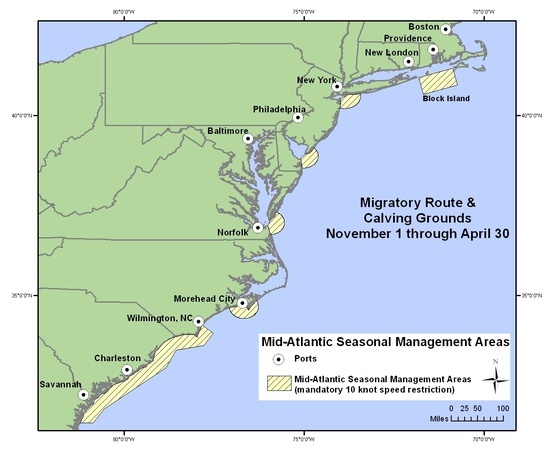In Effect November 1 through April 30
All vessels 65 feet (19.8 meters) or longer must travel at 10 knots or less in certain locations (called Seasonal Management Areas or SMAs) along the U.S. east coast at certain times of the year to reduce the threat of vessel collisions with endangered North Atlantic right whales. The purpose of this mandatory regulation is to reduce the likelihood of deaths and serious injuries to these endangered whales that result from collisions with vessel.Because vessels of all sizes can strike a whale, NOAA Fisheries also encourages vessels less than 65 feet in length to help protect right whales by slowing to 10 knots of less within active SMAs as well.
 Migratory Route and Calving Grounds, November 1 - April 30
Block Island Sound waters bounded by:
40º51'53.7" N 070º36'44.9" W
41º20'14.1" N 070º49'44.1" W
41º04'16.7" N 071º51'21.0" W
40º35'56.5" N 071º38'25.1" W then back to starting point.
Within a 20-nm (37 km) radius of the following (as measured seaward from the COLREGS lines):
-Ports of New York/New Jersey:
40º29'42.2"N 073º55'57.6"W
-Entrance to the Delaware Bay
(Ports of Philadelphia and Wilmington):
38º52'27.4"N 075º01'32.1"W
-Entrance to the Chesapeake Bay
(Ports of Hampton Roads and Baltimore):
37º00'36.9"N 075º57'50.5"W
-Ports of Morehead City and Beaufort, NC: 34º41'32.0"N 076°40'08.3"W
Within a continuous area 20-nm from shore between Wilmington, North Carolina, to Brunswick, Georgia, bounded by the following:
A- 34º10'30"N, 077º49'12"W
B- 33º56'42"N, 077º31'30"W
C- 33º36'30"N, 077º47'06"W
D- 33º28'24"N, 078º32'30"W
E- 32º59'06"N, 078º50'18"W
F- 31º50'00"N, 080º33'12"W
G- 31º27'00"N, 080º51'36"W
and west back to the shore.
Give Right Whales Room
North Atlantic right whales are on the move along the Atlantic coast of the U.S. NOAA is cautioning boaters and fishermen to give these endangered whales plenty of room. We are also asking all fishermen to be vigilant when maneuvering to avoid accidental collisions with whales and remove unused gear from the ocean to help avoid entanglements. Commercial fishermen should use vertical lines with required markings, weak links, and breaking strengths.
Right Whales in Trouble
North Atlantic right whales are protected under the U.S. Endangered Species Act and the Marine Mammal Protection Act. Scientists estimate there are only about 400 remaining, making them one of the rarest marine mammals in the world.
North Atlantic right whales are NOAA Fisheries' newest Species in the Spotlight. This initiative is a concerted, agency-wide effort to spotlight and save marine species that are among the most at risk of extinction in the near future.
In August 2017, NOAA Fisheries declared the increase in right whale mortalities an “Unusual Mortality Event,” which helps the agency direct additional scientific and financial resources to investigating, understanding, and reducing the mortalities in partnership with the Marine Mammal Stranding Network, Canada’s Department of Fisheries and Oceans, and outside experts from the scientific research community.
More Information
Recent right whale sightings
Find out more about our right whale conservation efforts and the researchers behind those efforts.
Download the Whale Alert app for iPad and iPhone
Acoustic detections in Cape Cod Bay and the Boston TSS, as well as other regions along the eastern seaboard.
Details and graphics of all vessel strike management zones currently in effect.
Reminder: Approaching a right whale closer than 500 yards is a violation of federal and state law.
Spread the Word!
All boaters, or interested parties, can sign up for email notifications and selecting "Right Whale Slow Zones" under the Regional New England/Mid-Atlantic subscription topics. You can also follow us on Facebook (@NOAAFisheriesNEMA) and Twitter (@NOAAFish_GARFO) for announcements.
Watch our video on Right Whale Slow Zones.
Recent Feature Stories about Right Whales
Listening for Right Whales in the Gulf of Maine
Make Way for Right Whales
10 Things You Should Know About Right Whales
|